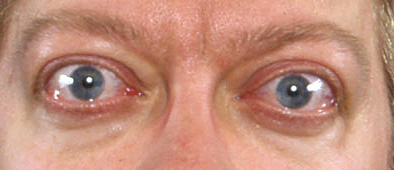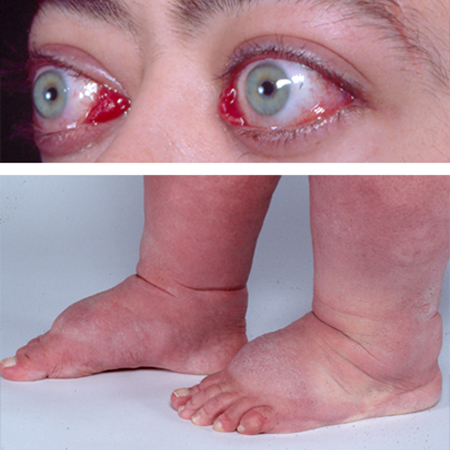History and exam
Key diagnostic factors
common
family history of autoimmune thyroid disease
Concordance rate among monozygotic twins is 20%. History of autoimmune thyroid disease in a first-degree relative increases the risk of development of Graves disease.[2]
history of tobacco use
Tobacco use is strongly associated with Graves hyperthyroidism, and numerous observational studies show that current and previous tobacco use increases the risk of orbitopathy 4- to 8-fold.[29] Among patients who have orbitopathy, the severe forms are more often in smokers. Tobacco use increases adipogenesis from orbital fibroblasts.[35]
heat intolerance
Relates to increased metabolism leading to higher body temperature.
sweating
Not to be confused with “hot flashes” related to estrogen deficiency.
weight loss
Is caused by accelerated metabolism and higher basal metabolic rate.
palpitations
Including atrial fibrillation or other supraventricular tachycardias, especially in older people.
tremor
Usually fine.[2]
diffuse goiter
Key diagnostic factor, especially in nonendemic areas. Goiter in combination with other symptoms and signs is a strong diagnostic indicator. Goiter may be difficult to identify in older people, especially if kyphosis is present.
orbitopathy
Clinically present in around 25% of patients and is usually mild.[1] Upper eyelid retraction is present in over 90% of cases. The presence of upper eyelid retraction with thyroid dysfunction, exophthalmos/optic neuropathy, and/or extraocular muscle involvement is diagnostic of Graves orbitopathy.[34] Subclinical abnormalities can be demonstrated by CT or MRI scan of the orbit, or by measurement of intraocular pressure in upward gaze.[65][Figure caption and citation for the preceding image starts]: Lid retraction, mild proptosis, and mild chemosisCourtesy of Dr Vahab Fatourechi [Citation ends].
Other diagnostic factors
common
irritability
Nonspecific.
cardiac flow murmur
Is due to the increased flow of blood through the heart valves.
moist, velvety skin
Suggestive of Graves disease, but not diagnostic.[66]
scalp hair loss
Nonspecific.[66]
sexual dysfunction
Hyperthyroidism has been reported to impair libido in men and women and erectile and ejaculatory dysfunction in men.[47]
uncommon
muscle weakness
May be generalized or proximal.
thyroid bruit
Less common than goiter in Graves disease, but has diagnostic value.[2]
onycholysis
Detachment of nail from nail bed, when present, is a good diagnostic physical finding.[2]
vitiligo
Associated autoimmune process that is not directly related to Graves disease but suggests an autoimmune diathesis.[66]
pretibial myxedema
May present as non-pitting edema, plaque, nodule(s), or elephantiasis.[19] Almost always associated with orbitopathy. The combination of Graves orbitopathy and dermopathy is highly diagnostic.[18][19][Figure caption and citation for the preceding image starts]: Pretibial myxedema (nonpitting edema)Courtesy of Dr Vahab Fatourechi [Citation ends]. [Figure caption and citation for the preceding image starts]: Orbitopathy and elephantiasisCourtesy of Dr Vahab Fatourechi [Citation ends].
[Figure caption and citation for the preceding image starts]: Orbitopathy and elephantiasisCourtesy of Dr Vahab Fatourechi [Citation ends].
acropachy
Due to subperiosteal new bone formation. Manifests as clubbing of the fingers and toes with soft-tissue swelling.[62] Almost always associated with orbitopathy.
menstrual irregularity
Menstrual disturbances are common in thyroid dysfunction. Oligomenorrhea may be present in severe hyperthyroidism.[46]
Risk factors
strong
family history autoimmune thyroid disease
female gender
Graves disease is 6 times more common in women than in men.[2]
weak
high iodine intake
lithium therapy
Long-term lithium use has been associated with a possible increased risk of hyperthyroidism due to painless thyroiditis or Graves disease. Lithium increases thyroid autoimmunity if present before therapy.[36]
biologic agent and cytokine therapies
radiation
radioiodine therapy for benign nodular goiter
Patients with benign multinodular goiters have been reported to develop Graves hyperthyroidism after radioiodine therapy, presumably because of release of thyroid antigens.[42]
Use of this content is subject to our disclaimer